PrAACtical Suggestions: How to Get Started with A New AAC Client
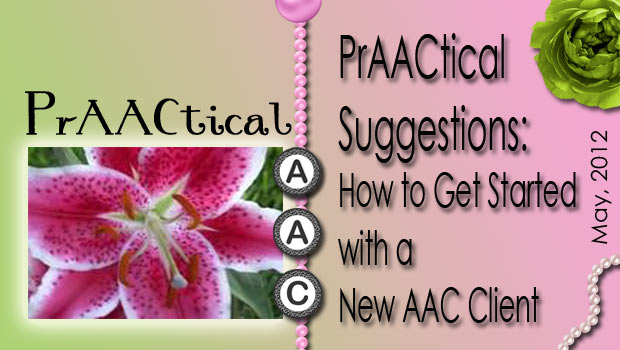
–
This is the first week of a new semester for us, and that means we get the pleasure of introducing a new crop of student SLPs to clients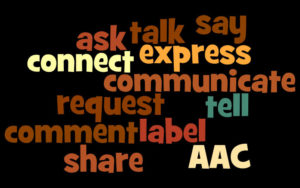 with AAC needs. We’ve been busy looking at lesson plans, discussing goals and objectives, listening to ideas for therapy activities, and helping to develop plans for data collection. With those recent conversations buzzing in our ears, here are some thoughts about getting AAC therapy sessions off to a good start.
with AAC needs. We’ve been busy looking at lesson plans, discussing goals and objectives, listening to ideas for therapy activities, and helping to develop plans for data collection. With those recent conversations buzzing in our ears, here are some thoughts about getting AAC therapy sessions off to a good start.
–
1. Connect with the client and family before the first session. Take some time to plan out questions that will help you get to know their expectations, family culture, and daily routine.
2. Know the history. Go beyond the diagnosis and device. Take time to research what’s been done before, how that worked out, and, if you can, how that was perceived. Knowing where the client has been on his/her AAC journey will help you plot out the next steps more thoughtfully.
3. Suspend judgement. You may find out some things that you don’t agree with or approve of, but force yourself not to judge. The reality is, we have no idea what it is like to live their lives. Judging your client’s family is not a right you’ve earned but more importantly, it will do nothing to make you a good clinician.
4. Activate your background knowledge. From your coursework, prior experiences, reading, and networking, you already know a lot about AAC, language intervention, and clinical processes. We’ve noticed that many times, though, clinicians don’t put into practice the knowledge they’ve gained. Our suggestion: Make a conscious decision to go back to course textbooks and notes that relate to your new 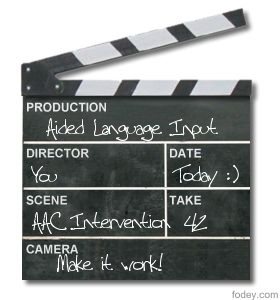 client’s needs. Skim through the relevant parts and make notes as to how to operationalize this in your therapy.
client’s needs. Skim through the relevant parts and make notes as to how to operationalize this in your therapy.
5. Make practice a priority. Sure, you know about aided language input, recasts, and least-to-most prompting. But how are your actual skills with these things? It takes time and effort to get good at implementation, and until you are good at implementation, your data is meaningless. Find someone to practice with and role play until you are fluent with the strategies you’ll be using in therapy.
6. Learn to triage. Focus your efforts on pivotal AAC skills and practices that will make your therapy effective in a variety of clinical situations. Sure, it is tempting to spend part of your evening making a new board game with Pixons but how much bang will you get for that buck? If you’re already a good interventionist, that may be fine. But if you’re still developing the fundamental clinical skills you’ll need in the session, perhaps that time is better spent in other ways.
7. Start with the client’s AAC goals and objectives. Most beginning SLPs tend to spend most of their time thinking about what activities they’ll do in the session. Then, when they get into the session, they aren’t very effective at eliciting the target behaviors. Often, that’s because the activity is not a good fit for the target skills. If you start by focusing on what behaviors you want the client to learn and demonstrate, you can then brainstorm a variety of activities that will target that skill and select the most appropriate ones for your session.
8. Know the difference between assessment and intervention. Sounds simple, but this is tough for many beginning SLPs to put into place. Looking at pictures and asking questions like ‘What is he doing?’ is a great way to find out what your client can do with his/her AAC system. But…It. Is. Not. Teaching. The only way a client can learn something new in that situation is by trial and error. They respond and you correct them. Learning by being corrected is not very efficient and it feels awful. Would you do well in a class that consisted primarily of tests and quizzes or would you achieve more if the professor taught the content? Focus on teaching, with some assessment and you will help your AAC clients achieve better outcomes AND have a great time doing it.
9. Take initiative. Search out experiences that will make you a better practitioner. Adequate student clinicians wait for those experiences to be brought to their attention. Good ones take the initiative to do this on their own. Find out where you can watch good clinicians in action or read their reports, articles, etc. Check out therapy interactions online. They aren’t all good, but you can critique them as you watch and that’s a good exercise in clinical reasoning.
10. Manage your expectations. No one gets to be a great SLP without time, effort, and practice. It’s a process. Your therapy will feel awkward at first, but be patient with yourself. If you’re one of the ones who really cares, you’ll get there.
–
Welcome to the new semester, folks. We have lots of prAACtical fun ahead of us!
–
Filed under: PrAACtical Thinking
Tagged With: intervention, SLP
This post was written by Carole Zangari

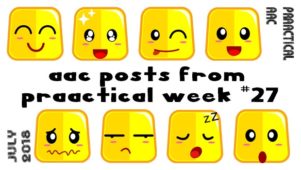
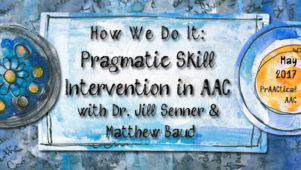

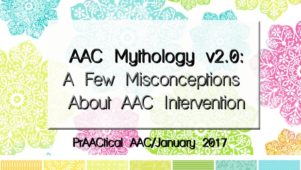
2 Comments
BarbaraI want to thank you for your blog. My nonverbal son is 3 1/2 and my heart aches for him. He does evryething a 3 year old should do and understands evryething, he just struggles to talk. Right now, we’re waiting for the insurance to come through so we can do private speech therapy as well as the school. We went through the early intervention program and he was placed in a half-day speech preschool. All the children in the class talk but have minor speech issues like stuttering and mild phonological disorders. I don’t think the teacher has seen anyone like my son before. The teacher is a speech therapist and does group therapy’. Yesterday she mentioned getting an assisted speech device to help him communicate. I was hoping that she would actually work with him in his speech but she told me those devices help apraxic children talk. I’m so confused. Although my son loves going to school I feel like he’s not getting the individual help he needs. I feel like the teacher is giving up’ on him and making it easier for herself by using this device with my son. I asked the school if they would pull him aside for individual therapy and they told me that they only offer group therapy. It’s as if they were saying this is what we have, you signed the IEP so take it’. So for now, I’m waiting for that approval to go through with the insurance and collecting some funds. I was thinking of pulling him out of that classroom but I have to make sure I have a back up plan first.
Thanks for your comment. I know it can be very confusing but the approach they suggest may be a very good avenue for your son. With good intervention, using an AAC device should help the development of his speech and language skills. It seems counter-intuitive, but our experience with children who have developmental conditions supports what the research has found. There is no evidence to suggest that using this approach will slow down his improvement, and will almost certainly do much to help his development. Apraxia is a stubborn disorder and it can take awhile before his speech to a point where he can say what he wants to. Using AAC will help him to develop language way beyond what his mouth can currently produce and reduce the frustration that many children with apraxia feel. Several young children with whom we’ve worked have become more intelligible with the addition of appropriate AAC services and devices. PLUS they’ve been able to advance their language skills and use longer sentences, more variety in their word forms, and other important skills. Without the AAC piece, they would have been much further behind in their language skills. Keep educating yourself on this topic so that you can make informed decisions. You are doing a wonderful thing for your son by researching this!